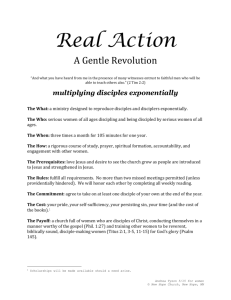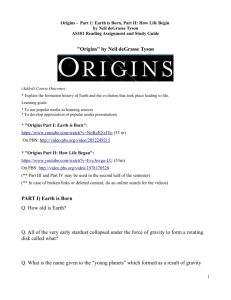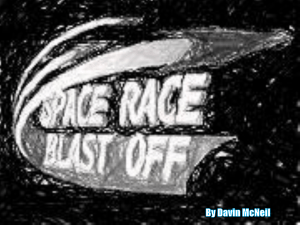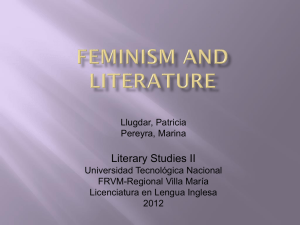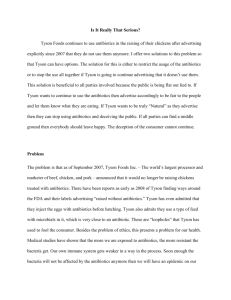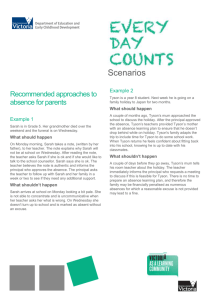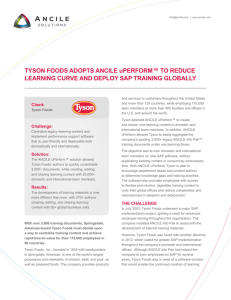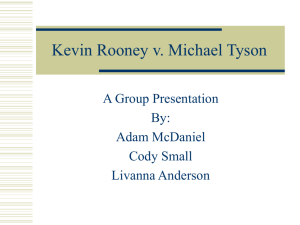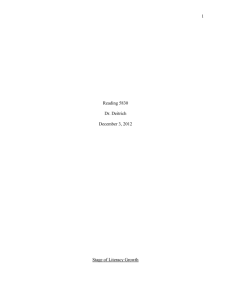editor`s introduction
advertisement
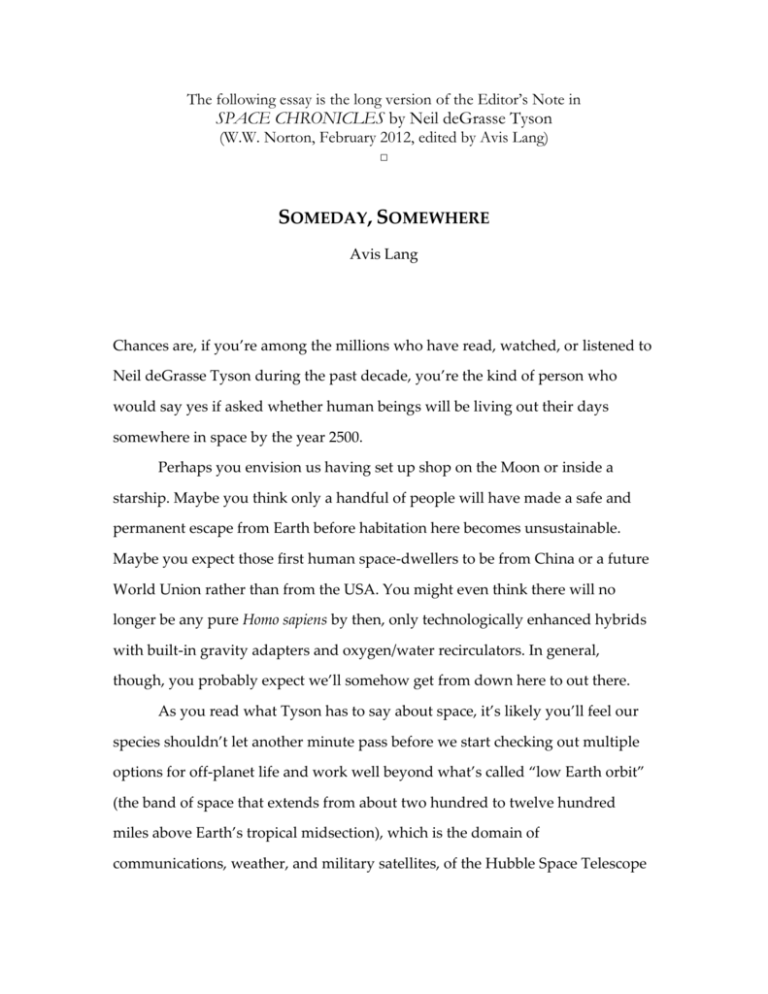
The following essay is the long version of the Editor’s Note in SPACE CHRONICLES by Neil deGrasse Tyson (W.W. Norton, February 2012, edited by Avis Lang) □ SOMEDAY, SOMEWHERE Avis Lang Chances are, if you’re among the millions who have read, watched, or listened to Neil deGrasse Tyson during the past decade, you’re the kind of person who would say yes if asked whether human beings will be living out their days somewhere in space by the year 2500. Perhaps you envision us having set up shop on the Moon or inside a starship. Maybe you think only a handful of people will have made a safe and permanent escape from Earth before habitation here becomes unsustainable. Maybe you expect those first human space-dwellers to be from China or a future World Union rather than from the USA. You might even think there will no longer be any pure Homo sapiens by then, only technologically enhanced hybrids with built-in gravity adapters and oxygen/water recirculators. In general, though, you probably expect we’ll somehow get from down here to out there. As you read what Tyson has to say about space, it’s likely you’ll feel our species shouldn’t let another minute pass before we start checking out multiple options for off-planet life and work well beyond what’s called “low Earth orbit” (the band of space that extends from about two hundred to twelve hundred miles above Earth’s tropical midsection), which is the domain of communications, weather, and military satellites, of the Hubble Space Telescope and the International Space Station, and vast quantities of potentially obstreperous debris. Right now, all our eggs are in one basket—our home turf and next-door space—which any good parent, president, or financial adviser will tell you is not the best way to plan for a secure future. The tasks and benefits are clear. The more engineers we nurture, the bigger and safer our space transport will be. The more familiar we become with asteroids and how to put distance between them and Earth and, when necessary, rejigger their orbits, the safer we’ll be. Increased analysis of the dynamics of the Sun—its magnetism, its radiation, its cycles, its deadly burps of plasma—would yield increasingly secure trajectories for our spacecraft. Increased understanding about how to find, use, and recycle the water on other celestial bodies would bring us closer to being able to spend time there. The more experiments we run with non-soil agriculture, the likelier it is our species won’t starve itself into extinction. And by the way, the more telescopic data we gather and analyze, the likelier it is we’ll discover complex life elsewhere in the universe. In September 2010 two US scientists proposed that the discovery of the first Earthlike planet (smallish, rocky, neither frigid nor fiery, endowed with liquid water and an atmosphere) would be announced in the first half of 2011, basing their “scientometric prediction” on the “ballooning” rate of discovery of exoplanets. A couple of weeks later—half a year early—an international team announced the discovery of the potentially habitable Gliese 581g, twenty light-years from our solar system and only a few times more massive than Earth. But until predictions are verified and tasks completed, we’re seemingly alone in the cosmos and stuck down here on our home planet. So while Tyson takes pleasure and pride in the capacity of human beings to dream and explore and invent—embodied in such marvels as the Soviet Union’s Sputnik spacecraft, America’s Saturn V rocket, the Hubble telescope, the International Space Station, and the Pioneer and Voyager probes currently coasting past the outer reaches of the Sun’s domain and on into interstellar space—he also worries. He fears that America is looking backward rather than forward, that our country is slipping back and cutting back and altogether lying back and biding time. He’s disturbed by irrationality and innumeracy and shortsightedness. He’s concerned about how to inspire eighth-graders to become scientists and engineers. He can’t help noticing that during his adult life, no astronaut has put boots on the Moon, let alone on Mars or beyond. He’s well aware of the role of profit, war, and glorification in determining which big projects garner money and which do not—and so he worries about NASA’s missions, and proposes (with a smile) that every government agency actually be funded at the level the public thinks it’s funded, in which case NASA might get a quarter of every tax dollar rather than half a penny. In short, when Tyson delves into the brief history of space exploration, he finds some aspects ennobling, some distressing, and others simply inescapable. In the opening pages of “A Story of the Days to Come,” written in 1897, the venerated science-fiction writer H. G. Wells introduces his readers to a “right and proper” Englishman named Mr. Morris, whose thoughts never strayed beyond his wife and children, his clothing and his household and his haircut— “one of those worthy people who take no interest in the future of mankind at all.” For Wells, intent on imagining the future, the Mr. Morrises of the world embodied complacency and willful ignorance: to them it was “quite impossible and quite uninteresting” to ponder what would happen in the years after their demise, let alone to plan for the inexorable future. For Tyson, who knows full well that the future is thoroughly indifferent to whether or not we’ve planned for its arrival, the Mr. Morrises are less an impediment than a challenge: he’s determined to reach them by any means available. As a consequence, Tyson (not being your average astrophysicist) can be read, heard, watched, and followed via an impressive range of venues. Readers of monthly magazines enjoyed his “Universe” column in Natural History Magazine from 1995 to 2008. Viewers of morning TV have caught him on The Today Show, The Early Show, American Morning, Good Morning America, or Fox and Friends. Fans of The Daily Show and The Colbert Report have watched him being interviewed by Jon Stewart and Stephen Colbert. Fans of public television have seen him host NOVA scienceNOW as well as several NOVA specials. Public-radio listeners in and around New York frequently hear him on WNYC. Readers of books can spend months reading Neil Tyson’s: he has written or co-written nine and has another few under way. If you work in the space industry, he may have delivered the keynote address at one of your recent conferences. If you’re graduating college, he might be your commencement speaker. If your organization wants to stage a debate on the compatibility of science and religion, he’s your man. And journalists in search of an inspiring person to profile need look no further. Because today’s media comprise not merely the old standbys but plenty of evolving alternatives, and because Tyson engages enthusiastically in most of them, it seemed appropriate to include in this anthology a sampling of the multifarious forums in which he has expressed his thoughts on the why, the how, and the why not of space exploration. Hence we’ve assembled essays, opeds, interviews, speeches, online commentaries, Q&A exchanges, and a scattering of tweets. Certainly an essay is very different from an interview, and a long speech before a homogeneous live audience is unlike a brief op-ed aimed at the heterogeneous public. Words on the page can be pondered at length; videos can feature a prop; radio can foreground the unadulterated sound of a mellifluous voice. Nearly every piece in this anthology has been adapted in one way or another to the print medium—streamlined, expanded, corrected, updated, divested of repetition—and yet nearly everything could easily be read aloud, because the sound of Neil deGrasse Tyson, if not his grins and outsize gestures and irrepressible presence, is embedded in everything he does. It’s been more than half a century since the Soviet Union put a small, beeping metal sphere into Earth orbit, and not much less than half a century since the United States sent its first astronauts for a stroll on the Moon. A wealthy individual can now book a personal trip to space for twenty or thirty million dollars. Private US aerospace companies are testing vehicles suitable for ferrying crew and cargo to and from the International Space Station. Satellites are becoming so numerous that low Earth orbit is almost running out of room. Tallies of orbital debris larger than half an inch now number in the hundreds of thousands. There is talk of mining asteroids and concern about the militarization of space. During the opening decade of this century in America, blue-ribbon commissions and reports initially fostered dreams not only of a swift US manned return to the Moon but more distant human space travel as well. NASA’s budgets, however, have not matched its mandates, and so America’s recent achievements beyond Earth’s atmosphere have involved human activities only within low Earth orbit, and only robotic activities at greater distances. Nevertheless, those achievements have been impressive: the delicate surgery performed by astronauts on the ailing Hubble; the heroic longevity of our robotic rovers on Mars; the Cassini spacecraft’s investigations of the surface hydrocarbon seas, the water-ice geysers, and the possibly life-hosting subsurface water oceans of Saturn’s and Jupiter’s moons. Meanwhile, not surprisingly, other countries have not been asleep at the wheel. China sent up its first astronaut in 2003; India plans to do the same in 2015. The European Union sent its first probe to the Moon in 2004; Japan sent its first in 2007; India sent its first in 2008. Russia plans a return visit in 2012. On October 1, 2010, the sixty-first National Day of the People’s Republic, China carried out a flawless launch of its second unmanned Moon probe, whose job is to survey possible landing sites for China’s third Moon probe, scheduled for 2013. Brazil, Israel, Iran, South Korea, and Ukraine, as well as Canada, France, Germany, Italy, and the UK all have well-established, highly active space agencies. Some four dozen countries operate satellites. South Africa has just formed a national space agency; someday there will be a pan-Arab space agency. Multinational collaboration is becoming de rigueur. Amid this rapidly evolving spacescape, some elements in America still repeatedly claim leadership, while others bemoan the nation’s dwindling primacy. Signs of wavering US leadership in space include termination of NASA’s Constellation program for human spaceflight; the absence of a securely funded, multiyear commitment to return astronauts to the Moon or more distant bodies; massive cumulative cuts in NASA’s technology programs; diminished support for science, education, and exploration; overreliance on Russian spacecraft for getting to and from the space station. In early 2011 NASA warned Congress that neither current launch-system designs nor current funding were capable of getting the US back to space by 2016. The state of our nation’s space endeavors could hardly be more bluntly characterized than in the opening paragraph of Seeking a Human Spaceflight Program Worthy of a Great Nation, the October 2009 report of a presidential commission—a report whose very title encapsulates the sense of unfulfilled aims: The US human spaceflight program appears to be on an unsustainable trajectory. It is perpetuating the perilous practice of pursuing goals that do not match allocated resources. Space operations are among the most demanding and unforgiving pursuits ever undertaken by humans. It really is rocket science. Space operations become all the more difficult when means do not match aspirations. Such is the case today. The problem isn’t restricted to space. A string of reports have registered alarm at the inadequacy or deterioration of US innovation, competitiveness, education, and forward planning in science and technology in general. In the winter of 2001, the Phase III report of the United States Commission on National Security/21st Century declared: Americans are living off the economic and security benefits of the last three generations’ investment in science and education, but we are now consuming capital. Our systems of basic scientific research and education are in serious crisis, while other countries are redoubling their efforts. In the next quarter century, we will likely see ourselves surpassed, and in relative decline, unless we make a conscious national commitment to maintain our edge. The commitment was not forthcoming. By the fall of 2010, when the National Academies (“Advisers to the Nation on Science, Engineering, and Medicine”) released a report with the red-alert title Rising Above the Gathering Storm, Revisited: Rapidly Approaching Category 5, the sense of decline was becoming widespread. Meanwhile, beyond our borders in fall 2010, science and technology and commitment were having some triumphs. Take the second week of October. Late that Wednesday, Chile finished orchestrating the rescue of thirty-three miners from a seventy-day ordeal in a collapsed copper and gold mine two thousand feet underground. On Friday, Switzerland finished drilling the world’s longest tunnel, enabling high-speed rail transport deep beneath the Alps, and the United Nations announced that its Food and Agriculture Organization had finally eradicated the worldwide cattle disease rinderpest. When did we last hear of a major long-term US scientific or technological public initiative to match the twenty-year period of the Swiss tunnel construction or the sixteen-year duration of the global anti-rinderpest campaign? Another take on priorities, commitments, and triumphs derives from one of Tyson’s core assertions: that massive, multiyear projects have been funded throughout history only if they could be justified in terms of the worship of power, the promise of profit, or the preparations for, or the actual waging of, war. In this longer view, what stands out is the stark, enduring quest for advantage, for primacy. Distinctions between public and private fade. Thus, the pharaohs of ancient Egypt invested in pyramids; the monarchs and burghers of early modern Europe invested in navigation; the politicians of contemporary America invest in military aircraft. Today America’s discretionary public dollars largely fund war. Tyson, being a peaceable, public-spirited, consensus-building fellow, would prefer that war and its offshoots were less of a money magnet. He would opt for cooperation rather than conflict. “How can it be so hard,” he asks, “for everyone to agree that the right direction for NASA is up?” After all, no one owns space; it is, as the world’s scientists recognize, a global commons, a domain suitable only for collectivity—and collective progress will continue despite crises, limitations, and setbacks. On a lighter note, Tyson also likes to point out that space has pervaded culture. Aside from all the planets, astronauts, and aliens for sale in supermarket cereal aisles and superstore toy departments, there are Cosmic Cafes, Cosmic Diners, Cosmic Coffees, Cosmic Fries, and Cosmic Clothings scattered far and wide. “Moonwalk” as a dance move is ensconced in the dictionary. TV has appropriated “Big Bang Theory” as the title of a sitcom. Google now has Google Sky; National Public Radio has a Planet Money team. The Hitchhiker’s Guide to the Galaxy is an industry unto itself. On YouTube, Monty Python’s Eric Idle can be watched forever crooning “The Galaxy Song” as he saunters amongst the stars with Mrs. Brown. Space has entered the language of finance, too. Robert Reich invokes the launch pad: “The national economy isn’t escaping the gravitational pull of the Great Recession. None of the standard booster rockets are working.” British economists invoke nothing less than the beginning of the universe—the Big Bang—to invoke October 27, 1986, the day the rules of the London Stock Exchange changed. Today journalists call almost any economic event with a sizable impact a big bang: the Obama administration’s 2009 stimulus, the US auto company bailouts, the soaring of gold prices, the creation of green jobs. Space imagery abounds in literature and the performing arts as well. The Canadian bass baritone Tom Graff created a performance opera in which ladies wearing immense feathered hats and elaborate Victorian gowns recite the countdown to the launch of Apollo 11 as they sit at a table sipping tea and awaiting the very first moonwalk. The American playwright Paul Zimet and composer Ellen Meadow conceived a work of musical theater about Kepler and Galileo. A walk-on character in the Brooklyn novel The Fortress of Solitude, by Jonathan Lethem, refers to the protagonist’s father as “a comet streaking past, whom we’ve managed to lure into our orbit.” The recipient of the Nobel Prize in Literature for 1996, the Polish poet Wislawa Szymborska, presents life on Earth anthropologically in her poem “Here” (“I can’t speak for elsewhere, / but here on Earth we’ve got a fair supply of everything”), describing an odd place whose inhabitants produce both crockery and musical instruments as they simultaneously “spin on the planet’s carousel” and “hitch a ride on the intergalactic blizzard.” Eventually, if not as astronauts then as atoms, we’ll all be caught up in that blizzard of icy dust, soundlessness, and electromagnetic radiation. But while you await that outcome, you might as well grab some Orbit chewing gum and Mars bars, don your NASA Astronaut Flight Jacket and your Planetary Backpack, and let Tyson take you for a test ride. Avis Lang New York City, February 2011 My gratitude to Surendra Parashar of the Canadian Space Agency and also to Norton Lang, Nivedita Majumdar, Fran Nesi, Elliot Podwill, Julia Scully, and Eleanor Wachtel for their indispensable input. © Avis Lang, 2012.
